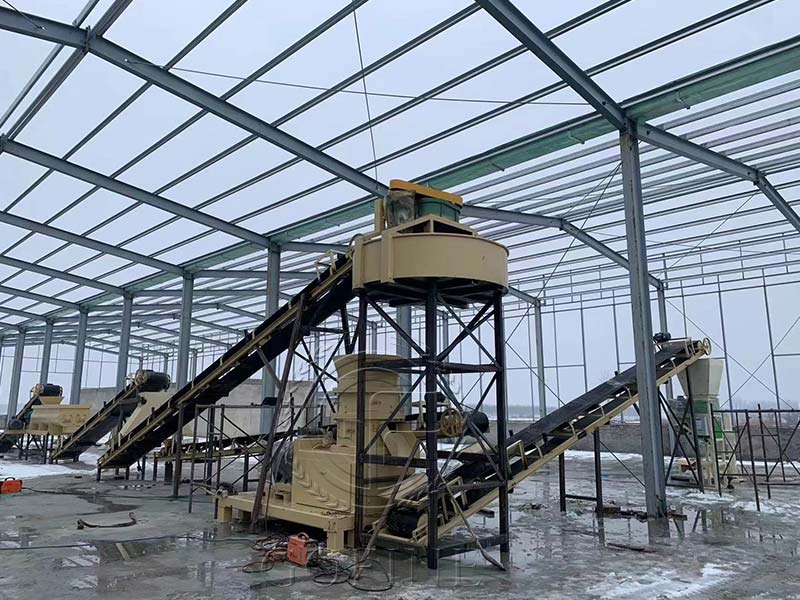Release time:December 6, 2024
I. Overview of the production line
The organic fertilizer ring die granulation production line is a set of professional equipment systems for the efficient production of organic fertilizer granules. It integrates advanced mechanical technology, automatic control system and granulation process, and can process organic raw materials into granular fertilizers with regular shapes and excellent quality to meet the needs of modern agriculture for organic fertilizers.

II. Main components
(I) Raw material pretreatment unit
Raw material collection and storage system
Includes various raw material storage bins for storing organic materials, such as livestock and poultry manure, crop straw, biogas residue, etc. These storage bins generally have good ventilation and moisture-proof measures to ensure that the raw materials will not deteriorate during storage.
Conveying equipment
Mainly belt conveyors, bucket elevators, etc. Belt conveyors can transport raw materials smoothly in the horizontal direction, while bucket elevators are responsible for lifting raw materials from low to high production links to ensure continuous supply of raw materials.
Crushing equipment
Chain crushers, hammer crushers, etc. are used to crush organic raw materials. Since organic raw materials such as straw may contain large lumps, crushing can make the raw material particle size meet the subsequent production requirements, which is conducive to uniform mixing and granulation.
(II) Batching system
Batching silo
Equipped with multiple independent batching silos, each silo is used to store a pre-treated raw material or additive. There is a precise metering device at the bottom of the silo, such as an electronic batching scale or a spiral feeder, which is used to accurately control the amount of each raw material added.
Batching control system
This system is an automated device controlled by a computer program. According to the pre-set organic fertilizer formula, the discharge speed and discharge amount of each batching silo are accurately controlled to ensure that each raw material is accurately mixed in proportion and the balance of fertilizer nutrients is guaranteed.
(III) Mixing unit
Double-shaft paddle mixer or horizontal ribbon mixer
When the batching is completed, the raw materials enter the mixer. The paddle or ribbon structure inside these mixers rotates at high speed driven by the motor, so that the raw materials can be mixed in all directions in the machine body. This movement mode can fully mix various raw materials in a short time and provide homogeneous materials for granulation.

(IV) Ring die granulation system
Ring die granulator
This is the core equipment of the production line. Its working principle is: the motor drives the main drive wheel to rotate the ring die, and the pressure roller rotates on the inner wall of the ring die. The raw material is forced into the extrusion zone between the ring die and the pressure roller. Under the strong extrusion force, the material is extruded through the die hole on the ring die to form particles. The aperture and thickness of the ring die determine the size and shape of the particles. Common particle shapes include cylindrical and other shapes. Moreover, the pressure, speed and other parameters of the ring die granulator can be adjusted according to the characteristics of the raw materials and the requirements of the particles.
(V) Post-processing unit
Drying equipment
The organic fertilizer particles that have just been granulated contain a certain amount of moisture, which needs to be removed by drying equipment. Commonly used drying equipment is a rotary dryer. In the dryer, hot air circulates through the pipes and fully contacts the particles to evaporate the moisture, reducing the moisture content of the particles to a suitable range, generally around 10% – 15%.
Cooling equipment
The temperature of the particles after drying is high and needs to be cooled. Air-cooled coolers are commonly used equipment. Through the circulation of cold air, the temperature of the particles drops rapidly and returns to the normal temperature state, preventing the particles from agglomerating and other quality problems during storage.
Screening equipment
It is used to screen out particles that do not meet the specifications, such as particles that are too large, too small or irregular in shape. Qualified particles are transported to the finished product packaging area, and unqualified particles are returned for reprocessing.
III. Production process
The organic raw materials start from the collection and storage system and are transported to the crushing equipment for pretreatment through the conveying equipment.
The pretreated raw materials enter the batching system and are accurately batched according to the set formula.
The prepared raw materials are fully mixed in the mixing unit.
The mixed raw materials are tempered and then enter the ring die granulator for granulation.
The granulated particles are dried, cooled and screened in turn. Qualified finished products are packaged and unqualified particles are returned for reprocessing.

IV. Product advantages
Excellent particle quality
The organic fertilizer particles produced by ring die granulation are uniform in size, smooth in surface, moderate in hardness, have good fluidity, and are easy to store, transport and fertilize. This regular shape of particles is conducive to the use of mechanized fertilization equipment.
Balanced nutrition
Accurate batching and sufficient mixing ensure that the nutrients in each granular fertilizer are evenly distributed, which can provide comprehensive and balanced nutrition for crops and promote the healthy growth of crops.
High production efficiency
The production line has a high degree of automation and each link is closely connected, which can achieve continuous and stable production. The efficient granulation performance of the ring die granulator also helps to improve the overall production efficiency and is suitable for large-scale production of organic fertilizers.
Environmentally friendly
Throughout the production process, the full utilization of raw materials reduces the emission of organic waste. At the same time, the drying and cooling equipment in the post-processing process is also equipped with corresponding environmental protection measures, such as dust recovery devices, to reduce pollution to the environment.